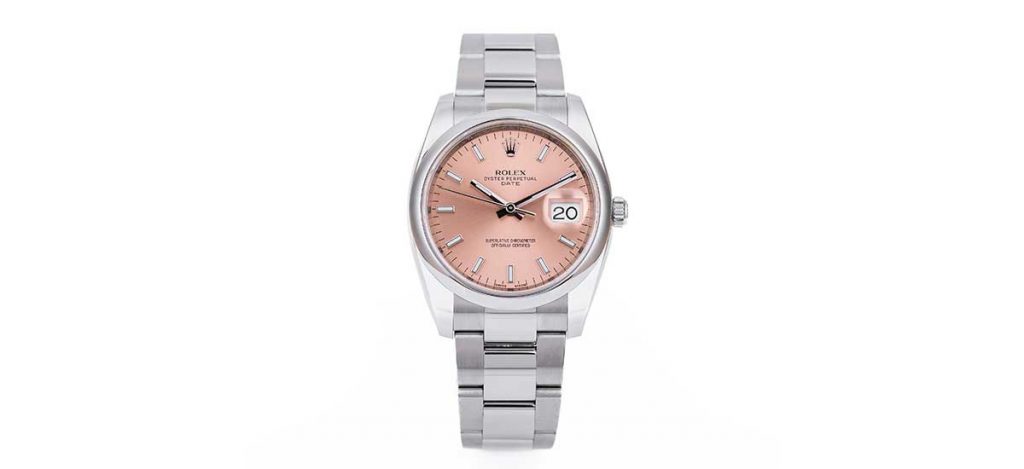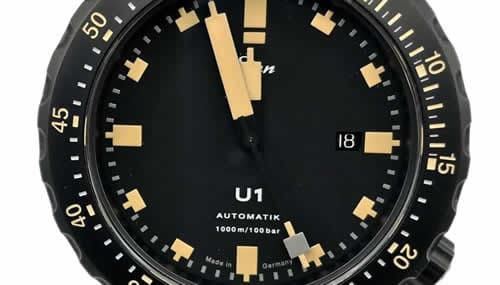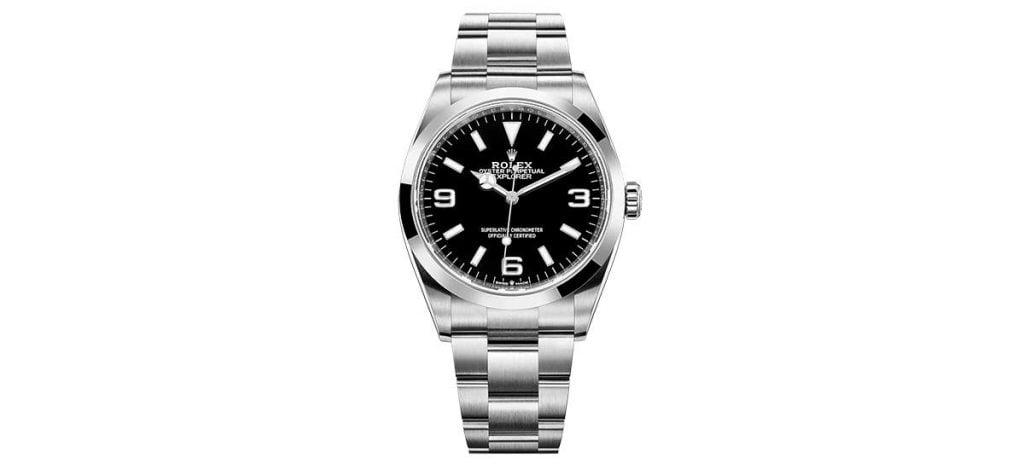
The year 1945 witnessed the end of the Second World War. It was also the year that Rolex released the Oyster Perpetual Datejust reference number 4467. The Datejust marked a major innovation in watch technology, with the first-ever date function. A remarkable feat for a company under normal circumstances.
However, Rolex managed to survive the war and emerged from the conflict, producing this breakthrough model in the face of nearly insurmountable supply chain disruptions.
The original Datejust commemorated the company’s 40th anniversary. It was first available in a manual wind movement, 36mm case size, 18k yellow gold, and featured a fluted bezel, cyclops date window, a waterproof Oyster case, and the now famous Jubilee bracelet.
The Datejust would ultimately become one of the most recognizable Rolex models and their all-time best-seller. Often referred to as the brand’s ‘workhorse’. By the mid-1950s, Rolex, without much fanfare, released the lesser-known little brother to the Datejust, the Rolex Date. The Date was essentially the same timepiece, but in a smaller, 34mm size and at a lower price point.
The big brother eventually expanded its offerings to include a plethora of dial and material combinations, along with multiple case sizes. At the same time, its younger sibling kept things simple, with one case size and a few combinations.
In this article, we’ll examine the commonalities and distinctions between the two collections. We’ll consider the design, functions, and features of some of their most popular versions over the decades to help you make the most informed decision in your next purchase.
About the Rolex Date
The Rolex Date was added to the Rolex roster rather quietly in 1955. Throughout most of its tenure, the collection has served as a smaller version of the Datejust collection and is nearly identical. Even comparing the watches side by side, it’s difficult to see the difference in size without tools of measurement.
The Date has a case size that measures 34mm and a 19mm lug width. Both watches were originally powered by a manual wind movement. Later versions featured automatic movements. The Date has always offered fewer customizations than the Datejust but a better price point.
Some might see the Date as an entry-level Rolex, and the price would suggest that. But the Date is a solid performer and every bit a Rolex. Sure, there are fancier models, but this is an excellent first Rolex or addition to one’s collection.
The model was discontinued in 2021, as subtlety as it was introduced, likely because the trend in men’s watches has been towards larger case sizes. It’s worth noting that the outgoing model didn’t receive the same upgrades to the movement the current Datejust offers.
About the Rolex Datejust
The Rolex Datejust, released in 1945, was the first timepiece to offer a date function, something that added great functionality and became a staple for many wristwatches. The original Datejust had a 36mm case size, but over the years, Rolex has offered it in different size options, including 31mm (primarily targeted to women) and 41mm.
Both the 36mm and the 41mm have a lug width of 20mm. Of course, the 31mm comes in a smaller lug width of 16mm. From the beginning, the model featured a magnified (by 2.5 times) date window at 3 o’clock, which has become known as a cyclops date, and is now synonymous with Rolex. It’s also known for its fluted bezel and its 5-link jubilee bracelet.
While there have been upgrades to the movement over the generations, the style has remained largely untouched. It’s a classic design that has targeted executives and professionals. Perhaps this has limited the collection’s audience to a more mature clientele.
While the collection tends to be viewed as a dressier sports watch, the timepiece can be dressed down by choosing options like a smooth bezel and the Oyster steel case and bracelet. The Datejust does offer a dizzying array of customizations.
One can choose a smooth or fluted bezel, as well as the Oyster or Jubilee bracelet. It comes in steel, white, yellow, and rose gold. The dial options are considerable, with black, shades of gray, silver, blue, green, and white. Some of the dials are textured or sunburst, and others are adorned with diamonds. There’s even an option for Roman numerals or simple indices.
Rolex Date vs Datejust: Which Should One Choose
The two collections have largely shared the same classic style, features, and movements throughout most of their histories. However, let’s consider some of the distinctions and finer points of comparison.
Model Options
The Rolex Date collection keeps it simple. There are fewer customizations, in contrast to its bigger brother, which presently offers different-sized cases and various style and material options.
Build
The Datejust and Date have a nearly identical build quality. Both have rugged, water-resistant Oyster cases. The case size of the Datejust has always been slightly larger and now comes in three different sizes. Both collections have the same basic bracelet options.
Movements
Both have often shared the same movements and features throughout their histories. When considering pre-owned vintage models, it’s worth noting that the Datejust 16xx and Date 15xx collections were the first to introduce the quickset date feature to the model lines.
This means that the date could be independently adjusted from the center hands; a time saving convenience. The latest Datejust features Rolex Calibre 3235 and offers a 70-hour power reserve. The last Date model from 2021 offered the older Rolex caliber 3135 with a 48-hour power reserve, which is not as advanced and accurate as the 3235.
Price and Availability
The current Datejust’s MSRP starts at around $7,000 for the 31mm and tops out at around $16,750 for the 41mm with options like rose gold and diamonds. If you fancy the Date, you’ll have to consider the pre-owned market, as this model has been discontinued; last offered in 2021.
One example from Watch Charts pegs the Rolex 115200 at a market price of $6,634, though the retail price will likely be higher. Some older models might be found for less. For example, some vintage models from the 1970s can be found for $3,195
Value Retention and Investment
Both collections tend to hold their value well. However, the Datejust is likely to appreciate faster, given that there are some configurations with diamonds and other precious metals, which increase the desirability and allow the timepieces to appreciate at a faster rate.
Notable Rolex Date & Datejust Models
ROLEX DATE REF. 115200

The Rolex Date originally arrived on the watch scene right at the midpoint of the 20th century, and while it’s no longer in production, this is a classic example of why Rolex just gets it right. It’s everything you want and expect from Rolex in a small package and at a reasonable price.
The 115200 has a polished stainless-steel case measuring 34mm, as all of the Rolex Date models do, and sits at 12mm on the wrist. The dial is black with silver hands and white Roman numerals.
However, there are different color configurations and simple index options for this model, as well. At 12 o’clock is the iconic raised Rolex five-point crown, and there’s the quintessential Cyclops date window at 3 o’clock.
The Rolex treatment and standards are seen in the details. Upon close examination of the timepiece, one can see the hands are polished by hand, not machine, and the print is clean and crisp. The polishing and fitting of the case are perfect.
That same attention to detail is continued with the movement. This model is powered by the caliber 3135 automatic movement, with a 48-hour power reserve. The Oyster bracelet completes the package for a timepiece that just hits the sweet spot.
Price: $6,390
ROLEX DATE REF. 6534

This is a true vintage model that’s rare and yet still reasonably affordable. Produced in the mid-1950s, the 6534 has a few unique features starting with the “ROLEX” signature in applied letters to the top half of the dial. At three o’clock, there’s a Cyclops roulette-style date window, with alternating red and black numbers, and the claw-shaped hour markers with double-pointed baton markers at 6 and 9, which transport one to another era.
Most of these come in a stainless-steel case measuring 34mm; however, there are some yellow-gold versions out there, as well. The dial color of the one highlighted here is referred to as radium burn, which to my eye, is a creamy light yellow.
The face is protected by a plexiglass, and the watch is powered by the caliber 1030 automatic movement. The timepiece was originally paired with a steel riveted Oyster bracelet with a folding clasp, though many on the pre-owned market have now been matched with leather straps.
Price: $4,850
ROLEX DATE REF. 1500
The Rolex Date 1500 is another vintage model that can be found at a modest price point. The 1500s were made in the ’60s and ’70s and offer the old charm of thick acrylic crystal, antique hands, indices, and the rivet link Oyster bracelets.
Most of these models are in stainless steel, but some are in yellow gold. One of this period’s most stunning and unique dials is their textured champagne face with the Tritium hands.
That one is a bit harder to get a price on, so the one featured here is their sunburst blue dial, which is still radiant after nearly 50 years. The timepiece is powered by the 1570 automatic movement and is paired with a stainless-steel Oyster bracelet with a folding clasp.
Price: $4,420
ROLEX DATEJUST 41 REF. 126334
The DateJust 126334 was first released in 2016 and is also the current model in 2023. This model has many different configurations with different material options in Oystersteel, White Rolesor, Yellow Rolesor, and Everose Rolestor, as well as a smooth or fluted bezel and an Oyster or Jubilee bracelet.
One can further customize their Datejust with multiple dial colors, some with textures and diamonds. The one we’ve selected is the Oystersteel and white gold. The white gold case measures 41mm and is fitted with a fluted bezel.
While the fluted bezel is thought of as a design feature today, it was originally designed to screw the bezel into the case, helping achieve a tighter seal and protecting against water penetration. The blue sunburst dial with white gold lined indices and a magnified date window at 3 o’clock is both well-made and lovely to behold.
So is the blending of the two metals, gold and steel. Gold is admired for its sheen and steel for its character; together, they make something special. The timepiece is thin, sitting at 12mm on the wrist. It’s paired with the Jubilee bracelet, which was originally designed for the 1945 Osterperpetual Datejust, and is a five-link metal bracelet that’s remarkably comfortable.
The bracelet boasts an Oysterclasp and a 5mm extension. Inside, the watch features the Rolex 3235 caliber automatic movement with a 70-hour power reserve. It’s also water resistant to 100 meters.
Price: $10,500
ROLEX DATEJUST OYSTERQUARTZ

The Oysterquartz was Rolex’s answer to the quartz crisis introduced by Seiko in the early 70s. Rolex stopped manufacturing the DateJust Oysterquartz in 2001, but some Rolex Oysterquartz models can still be found for a relative steal on the pre-owned market.
For this profile, we’ve selected a Datejust Oysterquartz from the late ’70s and ‘80s, the 17013. This is a handsome-looking two-tone watch in stainless steel and 14k yellow gold. The stainless-steel case measures 36mm and is fitted with a fluted yellow gold bezel. The dial of the timepiece is champagne with Tritium hands and a Cyclops date window at 3 o’clock.
As the name implies, the watch is powered by a quartz movement. It’s paired with a stainless steel bracelet, which has thin 14-karat yellow gold perpendicular links running down the center. This watch just feels like the 80s to me. I can see this on the wrist of some business tycoon of the era. It just puts out a cool vibe.
Price: $6,170
ROLEX DATEJUST 36 REF. 1600

In 1969 Rolex released the 1600, a version of the Datejust with a smooth bezel. Today it’s an option, but when the DateJust was first introduced, it only came with a fluted bezel, and that design feature gave the timepiece a dressier look. While only a subtle style change, this smooth edition made the watch more versatile.
The polished stainless steel case measures 36mm and sits on the wrist at 11mm thick. The silver sunburst dial with its raised baton hour markers and handset exudes class. There’s a Cyclops date window at 3 o’clock. The timepiece is powered by the Rolex caliber 1570 automatic movement and is fitted with a signed steel Oyster bracelet.
Price: $3,785
Parting Thoughts
Both the Rolex Datejust and Date are excellent, timeless designs. The Date is simplified and comes at a more modest price point, while the Datejust is highly customizable but more expensive. Outside of the modest size and customization differences, the two are incredibly similar, and one’s choice will come down to those little details of preference.





























